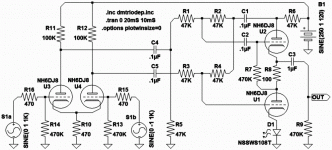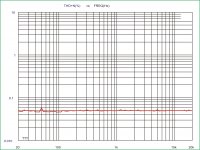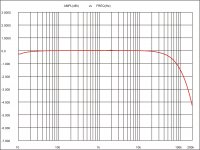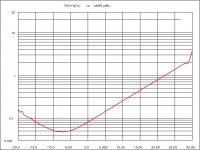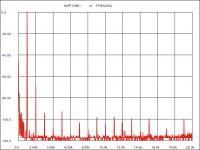Direct coupling to the power tube can give better performance if you drive the power tube to the point where it is drawing significant grid current.
The load presented by a power grid tube is nonlinear and asymmetric. A simple mu-follower has asymmetric drive capability in the right direction and far lower Zout than an SRPP. The mu-follower would be my obvious choice over SRPP for driving a power grid.
Gents,
I too hate Broskie and seldom bother reading him. Very seldom has be built anything he shows, or even simmed, and he ignores you if you email him protesting something he's posted.
Another publication I loath is Audio Express, as 90% of the articles are junk, but there are occasional gems there.And recently they have had a two part series on optimising the SRPP. Are any of you lot not up your noses too much to also look at it?
And as to it's (SRPP) name, I see NO chnace of any shunt regulation taking place, being quite a fan of real shunt regulation. I had seen the term "Single Rail P-P" in MJ mag at some time, in reference to a Lux tube preamp kit, and that what it was called then.
Regards, Allen
I too hate Broskie and seldom bother reading him. Very seldom has be built anything he shows, or even simmed, and he ignores you if you email him protesting something he's posted.
Another publication I loath is Audio Express, as 90% of the articles are junk, but there are occasional gems there.And recently they have had a two part series on optimising the SRPP. Are any of you lot not up your noses too much to also look at it?
And as to it's (SRPP) name, I see NO chnace of any shunt regulation taking place, being quite a fan of real shunt regulation. I had seen the term "Single Rail P-P" in MJ mag at some time, in reference to a Lux tube preamp kit, and that what it was called then.
Regards, Allen
I would prefer a common cathode stage loaded on a CCS with positive feedback by AC that depends on load resistance. And with negative feedback by voltage on DC (like a gyrator with negative losses).
What can be more linear?
Nothing. A tube loaded by a tube can't be linear, since a loading tube is a tube, but not an anti - tube. It does not have a mirrored curve. Period.
Hello,
anti – tube or not anti – tube it is a matter of degree.
What ever tube (envelope) is used the triodes are 180 degrees out of phase. Draw the curve on a clear piece of plastic, like used for an overhead projector. Now flip it over top to bottom. The before and after would be 100% canceling. Wait we are not finished yet. Now flip the transparency left to right. The curve is not only upside down but backwards left to right. This is the relationship of the curves in this series triode thing. Does this mean there is no canceling going on, no? Depending on the symmetry of the curve it could be perfect cancelation. Not bad, in fact very good for an all tube circuit from the 1940’s. This SRAR was not born an Aikido, it never had a proper name. Now the SRPP folks want to adopt it. Others want to turn it out on the street.
DT
All just for fun!
Hi,
The SRPP was sometimes used in TV circuitry where it was nicknamed a bootstrap follower.
This term, to my mind at least, is far more correct than calling this topology a SRPP.
Basically you have a voltage amplifier stage at bottom loaded by an active source strapped as a cathode follower.
The cf lowers Z out and you pay for that by losing about half the gain of the bottom stage.
Simply looking at the formula to calculate gain for such a stage makes everything clear.
As for the amazing low THD figures, well you can get low distortion from it if you meet a number of conditions.
Conditions which seriously reduce the usefulness of such a stage if you'd stick to the lowest possible distortion figs.
Shunt reg? Forget it. Regulated? Hardly. PP ? Somewhat yes....
PSRR not important? Maybe not provided all stages before it have excellent PSRR that is...
Cheers,
And as to it's (SRPP) name, I see NO chnace of any shunt regulation taking place, being quite a fan of real shunt regulation. I had seen the term "Single Rail P-P" in MJ mag at some time, in reference to a Lux tube preamp kit, and that what it was called then.
The SRPP was sometimes used in TV circuitry where it was nicknamed a bootstrap follower.
This term, to my mind at least, is far more correct than calling this topology a SRPP.
Basically you have a voltage amplifier stage at bottom loaded by an active source strapped as a cathode follower.
The cf lowers Z out and you pay for that by losing about half the gain of the bottom stage.
Simply looking at the formula to calculate gain for such a stage makes everything clear.
As for the amazing low THD figures, well you can get low distortion from it if you meet a number of conditions.
Conditions which seriously reduce the usefulness of such a stage if you'd stick to the lowest possible distortion figs.
Shunt reg? Forget it. Regulated? Hardly. PP ? Somewhat yes....
PSRR not important? Maybe not provided all stages before it have excellent PSRR that is...
Cheers,
Hi,
Why not rebaptise this topology and call it the CTP, Complementary Triode Pair?

Cheers,
Not bad, in fact very good for an all tube circuit from the 1940’s.
Why not rebaptise this topology and call it the CTP, Complementary Triode Pair?


Cheers,
Hi,
Why not rebaptise this topology and call it the CTP, Complementary Triode Pair?
Cheers,
Hey Frank,
I am not taking the orphan to church nor do I claim him as my own. It is just the fun of playing with the name. However I do like the cancelation of rp and halving of the gain. Plus ticking off the SRPP folks is a little fun.
Shunt sort of applies; half of the mu is diverted to the top tube. This meets the Webster definition of shunt.
Regulated sort of applies; when I think of regulators I think of a voltage divider with an actively controlled resistor. Typically in a shunt voltage regulator the active control device is the bottom device. For how shunt fits see above.
You can keep the PP push pull part.
So for this series triode thing with the load connected at the plate of the bottom triode I like the name Shunt Regulated Active Resistor.
SRAR
DT
All just for fun!
Fred, I mistook "Order of Magnitude" which is "Groessenordnung" in german for a colloquial use of the term magnitude in german. As mentioned, my fault. I some times get languages mixed up. Of course, never happens to you.
It happens.
I myself yesterday wrote, "Where do you leave?", instead of "Where do you live"? But what is strange, it was like a Freudian typo, like my subconscious mind knew he left California!
But does your subconscious mind feel that speaking of compensation of fine distortions of one tube you have to keep in mind that you are using another tube that adds similar distortions? That means, it i not enough to think about static properties of tubes, what swing in which direction, you have to think about how it swings, precisely: what happens to voltages, currents, resistances, in dynamics.
Do you hear me now about Anti-Tube?
Does Anti mean something different in German, or the same?
Depending on the symmetry of the curve it could be perfect cancelation.
All just for fun!
Yes! It could be perfect cancellation only and only if we had a tube with opposite dependences of internal resistance and amplification factor. It would be called Anti-Tube.
Hi,
Must be something along the lines of: "Die Gegenroehre"
Cheers,
Does Anti mean something different in German, or the same?
Must be something along the lines of: "Die Gegenroehre"
Cheers,
Since this thread has gone irrelevant numerous times already, I'll throw another curve.
You mention SRPP gainstage, not follower. But then Aikido and Broskie keep coming up.
The latter half of his circuit is unity gain follower for sure, with some tricks for PSRR.
I'm not sure why Aikido qualifies to be in this ring? But if it does, then so must this???
What we got here for SRPP duty, is a White Cathode Follower. But not just any old
WCF, this one is DIFFERENTIAL. And oddly enough had excellent PSRR properties too.
A follower by itself, has no voltage gain, only current gain. In fact this one actually
attenuates voltage by half if only a single input is driven. But a simple LTP up front
gives plenty of voltage gain. Similar part count vs Aikido, but full differential to SE.
Well anyways, its another circuit to chew on.
I've left 2VPP @120Hz ripple on the power rail, just to illustrate how it rejects.
Grid stoppers are not placed correctly, I should probably fix that next spin.
Won't make any difference to the LTSpice simulation, if you chose to run it...
You mention SRPP gainstage, not follower. But then Aikido and Broskie keep coming up.
The latter half of his circuit is unity gain follower for sure, with some tricks for PSRR.
I'm not sure why Aikido qualifies to be in this ring? But if it does, then so must this???
What we got here for SRPP duty, is a White Cathode Follower. But not just any old
WCF, this one is DIFFERENTIAL. And oddly enough had excellent PSRR properties too.
A follower by itself, has no voltage gain, only current gain. In fact this one actually
attenuates voltage by half if only a single input is driven. But a simple LTP up front
gives plenty of voltage gain. Similar part count vs Aikido, but full differential to SE.
Well anyways, its another circuit to chew on.
I've left 2VPP @120Hz ripple on the power rail, just to illustrate how it rejects.
Grid stoppers are not placed correctly, I should probably fix that next spin.
Won't make any difference to the LTSpice simulation, if you chose to run it...
Attachments
Last edited:
Gents,
I too hate Broskie and seldom bother reading him. Very seldom has be built anything he shows, or even simmed, and he ignores you if you email him protesting something he's posted.
...And recently they have had a two part series on optimising the SRPP. Are any of you lot not up your noses too much to also look at it?
And yet, I had an exceptionally fun time a few years back on a long beer-fueled walk in Langenargen with both of you.
I read the AX articles and the controversy. I did not come away from it feeling that anything had really changed- it was still a good circuit for its intended use, but not particularly low distortion, even with optimization. Both your circuits and mine do quite a bit better.
Ken, the Aikido looks something like an SRPP, but it's not. Higher output Z, lower distortion. The first I saw that circuit was in Landee, not sure of the date (probably 1950s).
His website looks like a magpie's nest: you can find there a golden ring with precious stone, spoons, pieces of wire - anything. But somehow, no one argues that the magpie invented rings with precious stones, nor that everything found in a magpie's nest is the best ...
Hi,
time ago I wrote two articles about Gomes circuit on Audioreview magazine in Italy.
In addition I wrote an additionla article where I developped a s.e. with a Gomes circuit ( 6N1P) that drive a 2A3.
In those articles I have tested 12 different tube: , Ecc88, ECC99, 6FQ7, 6H30, 12AT7, 12AX7, 5687, 5965, 7044, 7062 and 12BH7 ans 6FQ7.
Here you can fins, as an example, four test results:
1- 6fQ7A1 this is a frequency respinse; - 3B at 150KHz; very good
2- 6FQ7A2 thd versus frequency; 1 vout; it is very low
3- 6FQ7A3 thd versus amplitude; 0 dB = 2 volt; the increment is costant ( only IInd armonic; 20 dB means 20 Vrms out, 56 Vp-p)
4- 6FQ7A4 FFT at 1 vout , the first odd harmonic is at -100dB.
The resuslts are very interesting; in this case the Zout is 330 ohm and the gain is 16.
I check also for the Rx as the best load for the mininum THD; as you know the SRPP (and Gomes) are dipendent form the load as swing and distortion.
With 3900 ohm, with 2 Vout I got 0,008%.
I will back again with other results and additional consideration.
In every case the 2A3 s.e. with Gomes ( with a good seletion od tubes) sound very impressive; I will post the diagrams.
Ciao
Walter
time ago I wrote two articles about Gomes circuit on Audioreview magazine in Italy.
In addition I wrote an additionla article where I developped a s.e. with a Gomes circuit ( 6N1P) that drive a 2A3.
In those articles I have tested 12 different tube: , Ecc88, ECC99, 6FQ7, 6H30, 12AT7, 12AX7, 5687, 5965, 7044, 7062 and 12BH7 ans 6FQ7.
Here you can fins, as an example, four test results:
1- 6fQ7A1 this is a frequency respinse; - 3B at 150KHz; very good
2- 6FQ7A2 thd versus frequency; 1 vout; it is very low
3- 6FQ7A3 thd versus amplitude; 0 dB = 2 volt; the increment is costant ( only IInd armonic; 20 dB means 20 Vrms out, 56 Vp-p)
4- 6FQ7A4 FFT at 1 vout , the first odd harmonic is at -100dB.
The resuslts are very interesting; in this case the Zout is 330 ohm and the gain is 16.
I check also for the Rx as the best load for the mininum THD; as you know the SRPP (and Gomes) are dipendent form the load as swing and distortion.
With 3900 ohm, with 2 Vout I got 0,008%.
I will back again with other results and additional consideration.
In every case the 2A3 s.e. with Gomes ( with a good seletion od tubes) sound very impressive; I will post the diagrams.
Ciao
Walter
Attachments
His website looks like a magpie's nest: you can find there a golden ring with precious stone, spoons, pieces of wire - anything. But somehow, no one argues that the magpie invented rings with precious stones, nor that everything found in a magpie's nest is the best ...
His website looks like a magpie's nest: you can find there a golden ring with precious stone, spoons, pieces of wire - anything. But somehow, no one argues that the magpie invented rings with precious stones, nor that everything found in a magpie's nest is the best ...
You nailed it with that analogy! A dangerous place for noobs like me.
Jeff
You nailed it with that analogy! A dangerous place for noobs like me.
Not at all!
He has a lot of information, and encourages you to experiment, if you don't treat it as a Bible!
Hey, the Bible is full of contradictions too.
Yes, and also should encourage to experiment!
(However, they used to burn experimenters on stakes, the same may happen as the result of experimenting with electronics, but....)
- Status
- This old topic is closed. If you want to reopen this topic, contact a moderator using the "Report Post" button.
- Home
- Amplifiers
- Tubes / Valves
- SRPP vs. plate loaded, musicality and details
